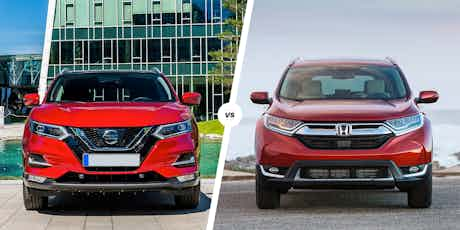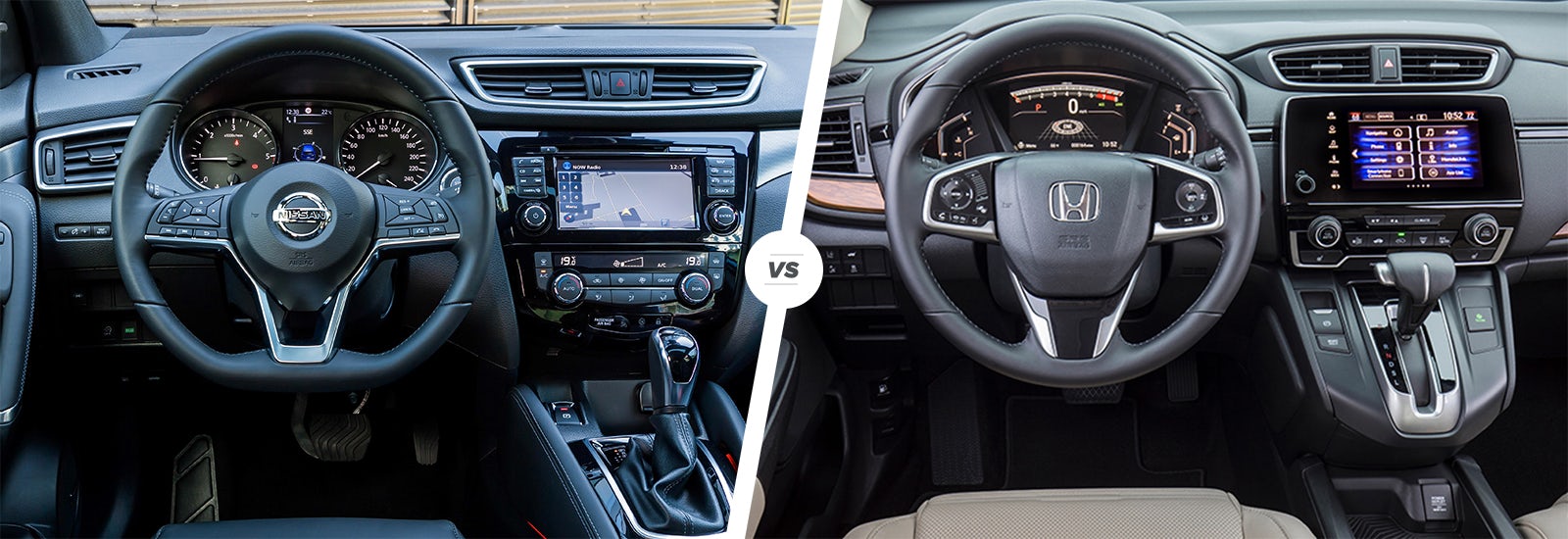Nissan Qashqai vs Honda CR-V: which is best?
June 28, 2017 by carwow staff

The Nissan Qashqai is one of the most popular SUVs on sale in the UK and a recent update brought new styling and a refreshed cabin. Hailing from the other side of the Atlantic is the new Honda CR-V – an entirely new replacement for the firm’s popular compact SUV due on sale in 2018.
Check out our Nissan Qashqai deals and our deals on the outgoing Honda CR-V or view carwow’s latest savings on our car deals page. Click ‘login’ on our homepage to sign up and configure a new car or view our extensive range of new, nearly new, pre-reg and ex-demo stock cars.

Nissan Qashqai vs Honda CR-V prices
Honda hasn’t released pricing details for the latest CR-V so we’ll use prices from the outgoing model as our basis. If you park the Qashqai next to the CR-V, you’ll notice the latter is significantly bigger and the prices reflect this. This is because Honda is aiming the CR-V at models in the segment above including the Ford Edge and Mazda CX-5. Entry level Nissan Qashqais feature a 115hp 1.2-litre turbo petrol engine and cost £18,955 – in comparison an entry-level Honda CR-V comes with a 155hp 2.0-litre non-turbo petrol engine and costs £23,475.
Throughout the range, you’ll find the CR-V tends to be around £4,000 more expensive than an equivalent Qashqai – for example, a 130hp 1.6-litre diesel Qashqai costs £20,755 while a 120hp 1.6-litre diesel CR-V costs £24,515. It really is just the extra space you’re paying for, too, because both entry-level cars get cruise control, Bluetooth connectivity, air conditioning and LED daytime running lights, with the CR-V only edging ahead thanks to standard alloy wheels.

Nissan Qashqai vs Honda CR-V styling
Nissan gave the Qashqai the nip and tuck treatment in 2017 to keep it looking fresh. The new model gets a larger chromed V-shaped element in the front grille, while the headlights have become even more pointed. Down the sides, the same neat creases as the pre-facelift Qashqai remain and help break up the bodywork effectively, while the rear gets a slightly reshaped bumper and new designs for the brakelights. Overall, the Qashqai looks neat and tidy but is unlikely to set many pulses racing.
Those after a stylish car are no better served by the Honda CR-V, despite being an entirely new design. Its conservative styling has left it with a body that looks very similar to the model it replaces with an upright stance and very few creases employed to reduce the expenses of metal that make up its sides. The back gets more keenly styled brakelights connected by a chrome strip but it’s not enough to stop the CR-V looking just a little dull. On the other hand, that bulky body does mean it can offer more cabin space than the Nissan.

Nissan Qashqai vs Honda CR-V interior
The 2017 update brought some new features to the Qashqai’s cabin including a redesigned steering wheel and an upgraded layout for the infotainment system. Apart from that, it’s much the same as the pre-facelift Qashqai’s cabin with a button-heavy tapered centre console and a general sense of durability throughout. Rear space is decent with two passengers but sitting three across the bench seat is a bit of a squeeze. The 430-litre boot is just large enough for a family’s luggage and loading large items is reasonably easy thanks to the car’s square opening.
While its exterior might be a bit forgettable, the CR-V’s cabin is more interesting than the Nissan’s. It benefits from a neater design for the centre console and clearer graphics for its infotainment system, while digital dials help it feel more modern than the Qashqai. Being the larger car here, the CR-V offers much more interior space – it still only seats five but is much more able to take three passengers across the rear row without them feeling cramped. Its 1,100-litre boot comfortably smashes the Qashqai’s comparatively modest load bay.

Nissan Qashqai vs Honda CR-V driving and engines
On the road, the Qashqai makes a strong case for itself by focusing on what family car drivers really need – comfort. It uses comparatively complex suspension normally found in high end cars that means it can both float over big bumps and smooth out rough road surfaces – something few cars do well simultaneously. This relaxing atmosphere is backed up by controls that respond accurately without demanding too much effort from the driver. The lower-powered engines suit the Qashqai best with the 1.2-litre petrol and 1.5-litre diesel both providing adequate power and fuel economy.
We’ve not driven the new CR-V in the UK yet but, based on reviewers in the US, it seems to be a marked improvement on its dull-to-drive predecessor. Through corners it remains admirably flat while the centre of gravity feels low, adding to its sense of stability. Reviewers also report that it handles bumps with ease, although whether that translates to the UK’s pock-marked roads or not remains to be seen. The controls are, like most recent Hondas, pleasantly accurate with the brake pedal reportedly feeling especially responsive in use.

Nissan Qashqai vs Honda CR-V verdict
Being positioned at such different price points means there’ll probably be little crossover for buyers of either. If you’re looking at spending more than £25,000 then the CR-V makes a strong case for itself with a composed driving experience, a spacious cabin and a vast boot. If, however, your budget is more modest, the Qashqai is still a strong contender with excellent comfort and useful levels of practicality.
Cars Change? Carwow!
Looking for a new set of wheels? With Carwow you can sell your car quickly and for a fair price – as well as find great offers on your next one. Whether you’re looking to buy a car brand new, are after something used or you want to explore car leasing options, Carwow is your one stop shop for new car deals.















